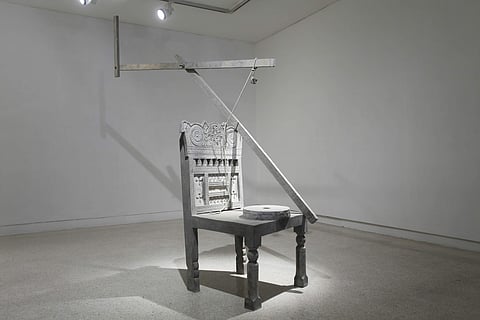
- LIFESTYLE
- FASHION
- FOOD
- ENTERTAINMENT
- EVENTS
- CULTURE
- VIDEOS
- WEB STORIES
- GALLERIES
- GADGETS
- CAR & BIKE
- SOCIETY
- TRAVEL
- NORTH EAST
- INDULGE CONNECT

A deceptively simple theatrical element in the work “Obituary” (2013) by LN Tallur makes it stand out like a charm among the selected works on display at The Sculpture Park at Madhavendra Palace, Nahargarh Fort, Jaipur.
A block of wood placed on a wooden brace lies seemingly embalmed on the floor, with an uncountable number of coins nailed and wedged into the bark — making them stand on end, like spines.
There’s an added impression of a mythical beast at rest, with burning fragrance embedded in the log. The coins used in the work were sourced from temple donation boxes, while the fragrance from the incense lends a calming air to the installation, also conveying a propitiatory sense in reference to commonly observed funeral rituals.
Tallur, who’s known for his sculptures and interactive works that “muse over the strangeness of everyday life”, also presents “Chromatophobia” (2012) at the park, which is set to be opened this weekend. In “Chromatophobia”, a tree trunk appears to have crashed into a full-sized granite figure of the Laughing Buddha, while the log bears more of Tallur’s coins.
Dubbed “India’s first sculpture park”, and a project of the Government of Rajasthan in collaboration with Saat Saath Arts Foundation, the park will witness the transformation of the erstwhile fortress Nahargarh, which stands on the edge of the Aravalli Hills, and once formed a ring around Jaipur, with the forts of Amer and Jaigarh.
Tallur is one among 15 Indians, apart from nine international artists, whose works have been curated by Peter Nagy, of Nature Morte in New Delhi, for the opening show, which will also lay the foundation for an annual fixture on the national cultural calendar.
Destination Jaipur
Among other works, the inaugural edition includes a series of amorphous Buddha figurines made of Hydrocal plaster and acrylic paint skins by Arlene Shechet, works of marble and stone by Gyan Panchal from Paris, decorative pieces in bronze by James Brown, and a series of typically urbane and modernistic compositions made of iron, granite and terracotta tiles by the duo of Jiten Thukral and Sumir Tagra, apart from “Memorial-a”, involving a table tennis board and a Gandhi statue.
A stand-out work here by Thukral and Tagra presents an imposing carving in concrete, of a seeming clipped wing, made of marble chips and resin, and titled, “Arrested image of a dream — Stone wings (b)”.
Evan Holloway’s minimal “Untitled” (2017) of bronze and oil enamel adds some colour and abstracted form to the collection. Alongside, Vibha Galhotra’s “Flow” (2015) is a rather unusual conception too — lining the corner of a room in a fluid arrangement of nickel-coated ghungroos, fabric and PU, lending the impression of oil and sludge dripping and seeping through the crevices, and spilling onto the floor in a murky puddle of rippling metals and minerals.
For Nagy, the park hews closer to his ideal of breaking away from “white-box exhibition spaces”, at the same time, combining art with architecture and decor into what he describes as “a marvellous synthesis of the past and the present”. In effect, the Sculpture Park is set to establish a more prominent presence alongside festivals such as Magnetic Fields in Alsisar, Sacred Music in Pushkar, the Jaipur Literature Festival, and Jaipur Photo.
Conversation points
The open courtyards at the fort afford the inclusion of large-size works such as Huma Bhabha’s “God of Some Things” (2011) cast in bronze. Bharti Kher presents “choleric, phlegmatic, melancholy, sanguine” (2009-17), a ghoulish conception of figures with conches implanted in their heads, in some way reminiscent of the Gorgons of Greek mythology, as well as “Impossible Triangle”, an intricate sculpture of cement, with a contraption of bolts and electric wire, playing on the idea of “place and the elusion of place”.
The park also brings together works by Astha Butail (2017 BMW Art Journey award winner) and Anita Dube (who will also be curator of the Kochi-Muziris Biennale 2018), apart from Huma Bhabha, Arman, Asim Waqif, Stephen Cox, Subodh Gupta, Vikram Goyal, Matthew Day Jackson, Hans Josephsohn, Reena Kallat, Mrinalini Mukherjee, Manish Nai, Prashant Pandey, Benitha Perciyal and Ravinder Reddy.
At the show, Jitish Kallat’s works will draw a lot of attention too. At close inspection, “Annexation” (2009) of black lead, pigmented resin and steel, depicts hundreds of fantastical beasts scrambling all over and devouring each other, in an epic conception of annihilation, arranged in the form of a six-foot kerosene stove.
On the other hand, “Vertical Chronicle of a Turbulent Equilibrium” (2013), ostensibly a step ladder of pigmented resin, steel and rope, might be the most austere work of the collection, but is sure to make for a compelling talking point among viewers at the show’s opening.
The Sculpture Park will be unveiled in Jaipur on December 10.